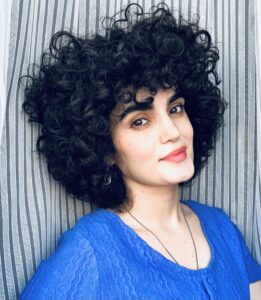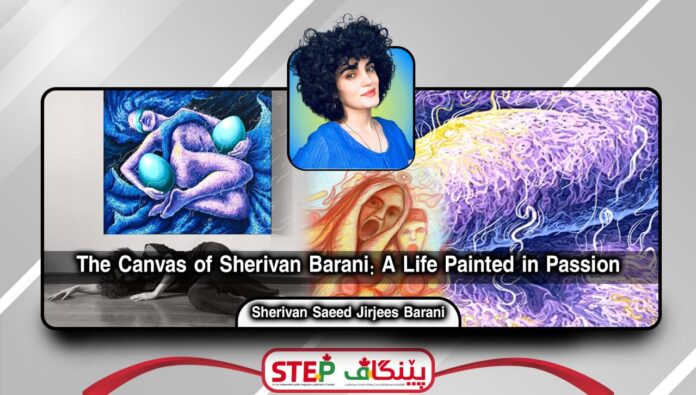A STEP Magazine Interview with Sherivan Barani
Introduction:
Who is Sherivan Barani, and how does she want to be known?
My name is Sherivan Saeed Jirjees Barani, but most people call me “She” a nickname my mother gave me when I was a child. It’s more than just a name; it’s a piece of her love that has stayed with me throughout my life. I carry it with pride, as a reminder of her warmth, strength, and the affection that shaped so much of who I am today.
I want to be known as an artist who speaks through her work—not just in colours and forms, but in emotions, stories, and cultural identity. I want my art to reflect the journey of a Kurdish woman finding her voice, preserving her roots, and sharing them with the world.
About Your Art:
What inspired you to become an artist?
My greatest inspiration has always been my father. He’s a man deeply in love with art and culture, and from a very young age, he made sure I was surrounded by it. I remember watching him talk about paintings, music, and Kurdish heritage with such passion—it planted a seed in me.
He didn’t just encourage me; he walked beside me on this path. When I first picked up a pencil to draw, he was the first to notice. When I wanted to explore, he opened doors. And when I doubted myself, he reminded me why I started.
Art became the language through which I could express not only my thoughts and emotions but also the soul of where I come from. And even now, with every step I take as an artist, my father is still there cheering me on, offering advice, and believing in me more than I sometimes believe in myself. He is not only the reason I became an artist, but also the reason I continue to be one.
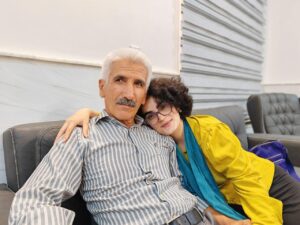
How does your Kurdish heritage influence your art?
Being a Kurdish woman is both an honour and a profound challenge. Kurdish women have carried generations of strength, resistance, and resilience—often in silence, but always with dignity. In a world where many still struggle to understand our reality, we continue to stand tall, preserving our identity and culture with fierce pride. That powerful spirit lives at the heart of my art.
Kurdish heritage is filled with beauty, symbolism, and emotional depth. One of the most powerful symbols for me is hair—especially women’s hair and braids. In our culture, hair is more than appearance. It’s identity. It represents femininity, strength, tradition, and even resistance. A woman’s braid is like a story woven strand by strand: a connection to her roots, her family, her past, and her hope for the future.
In my artwork, I often use braids and hair as central elements, because they embody the voice of Kurdish women. They are symbols of pride and endurance, deeply tied to who we are. Through my art, I try to reflect that beauty and complexity—to show the world what it means to be a Kurdish woman, and how our culture breathes life into everything we create.
Can you describe the themes or messages you try to convey through your work? Which of your artworks are you most proud of, and why? How do you balance creativity with the technical aspects of art?
The message I always try to share through my artwork is that the woman—and her body—is sacred. For me, a woman’s body is not something to be seen through the lens of desire or shaped by societal ideologies. Instead, I see it as a symbol of beauty, power, and life itself. Women are natural beings, created to carry the cycle of life forward. That alone is divine. Through my art, I try to shift the perspective away from objectification and toward appreciation—toward honouring the essence of femininity.
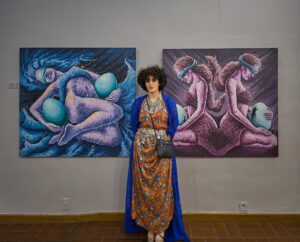 Among all my works, the pieces that center around women are always closest to my heart. But the one I’m most proud of is my graduation project, “Flying with Folded Eyes.” It was the first time someone in our college approached such a deeply sensitive and symbolic theme with that level of detail and care. Every single line, every texture, was drawn with love and deep respect for women. I wanted the viewer to feel it—and they did. It became the focal point of attention, and that reaction reminded me why I chose this path.
Among all my works, the pieces that center around women are always closest to my heart. But the one I’m most proud of is my graduation project, “Flying with Folded Eyes.” It was the first time someone in our college approached such a deeply sensitive and symbolic theme with that level of detail and care. Every single line, every texture, was drawn with love and deep respect for women. I wanted the viewer to feel it—and they did. It became the focal point of attention, and that reaction reminded me why I chose this path.
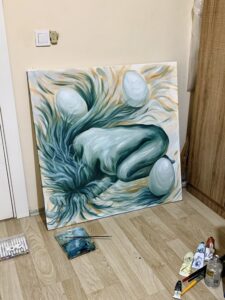
As for balancing creativity with technique, I truly believe it’s all about planning and intention. When you understand the elements and principles of art—and use them consciously—they don’t limit you. In fact, they support your vision and give your creativity structure. For me, it’s not difficult to stay balanced, because both sides feed into each other. Creativity gives my work soul, and technique gives it form.
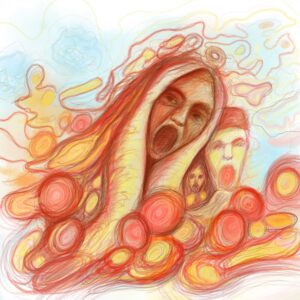

Teaching and Mentorship:
What motivated you to become an art teacher?
Becoming an art teacher was truly my childhood dream. When I was in school, we didn’t have dedicated or specialised art teachers—and that left a deep impact on me. Even back then, I told myself: One day, I will become an art teacher who teaches with heart and soul. I wanted to make art as serious and respected as subjects like math or science, but still fun, creative, and deeply meaningful. That promise became my passion.
How do you encourage your students to find their unique artistic voice?
It wasn’t easy at first, I never studied art education formally, so I had to find my own method. Through self-learning, research, and observing the best global art teachers, I discovered many ways to connect with students. I also spent time learning about children’s psychology and how creativity works at different ages. These efforts helped me develop a teaching style that balances freedom with structure.
In my classroom, I encourage students to explore different techniques and mediums freely while also teaching them the fundamentals of art—composition, perspective, colour theory, and so on. This balance allows each student to discover their own voice while still developing strong artistic skills. The result? Many of them have grown into truly talented young artists, and the art room has become one of their favourite places in school.
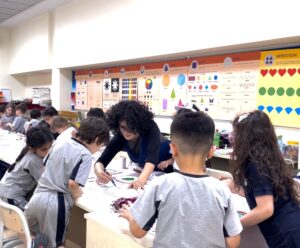
Have you noticed any specific challenges Kurdish students face in pursuing art, and how do you support them?
Yes, especially at the beginning of my career, I noticed that many Kurdish students weren’t familiar with the value of art. For some, it was seen as just a side subject—not something to take seriously. That made me even more determined to change their perception.
Through consistent effort, passion, and by creating a welcoming and inspiring space, I was able to plant the seed of art in their minds. Now, my students understand that art is not just about drawing or painting—it’s about expression, communication, and even healing. They see it as an important life skill, and that shift has been one of the most fulfilling parts of my journey.
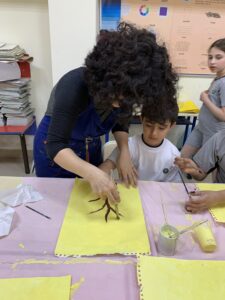
What’s the most rewarding part of teaching art?
Wow—it’s hard to put into words. But I’d say the most rewarding part is how it makes you feel on the inside. It fills your heart, connects you with your inner child, and brings you this incredible sense of joy and purity. When a student creates something beautiful, or when their eyes light up because they’ve discovered a new skill—that feeling can lift your whole day. It reminds me why I chose this path.
For beginners, I focus on making them feel safe to experiment. I give them simple tools and techniques, and lots of encouragement, so they can build confidence and enjoy the process. For advanced students, I guide them toward deeper artistic thinking—more complex techniques, critical analysis, and helping them refine their own unique style. But no matter the level, I always try to keep the joy of creation at the center of everything.
Personal Journey and Challenges:
What were the biggest obstacles you encountered as a Kurdish woman pursuing a career in the arts?
As a Kurdish woman, one of the biggest obstacles I’ve faced in pursuing a career in the arts has been the weight of cultural beliefs and religious norms. In our society, being both an artist and a woman often means facing limits—boundaries placed on what you can express, how you’re seen, and whether your work is even accepted. Many people still don’t see art as a “real profession,” especially for women. They believe it can’t provide a stable living, and they often reject the deeper meanings behind certain kinds of art, especially if it challenges traditional views.
Have you faced any resistance or criticism from your community, family, or society for choosing art as a profession?
Yes, I’ve faced criticism—more than just words. Both society and even some parts of my extended family made it clear that they saw art as a failure. I was told directly, “You’re not going to be successful if you choose this path.” But ironically, I’m making my living today because of art. I’ve built my career, my identity, and my future on something they thought was impossible.
How have you overcome gender-based challenges in the art world?
Gender equality is still a struggle in our society, and through my art, I try to challenge those norms. I focus on normalising the presence and power of women in the artistic space—reclaiming their stories and expressing them honestly. I still face stereotypes and misconceptions, but every piece I create, every class I teach, is part of a bigger effort to rewrite that narrative.
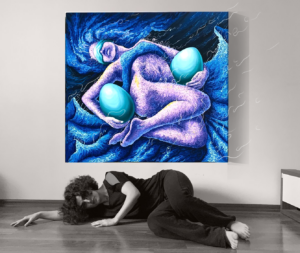
One of the most emotional and defining moments in my life was when my father, my biggest supporter, once took me to an art exhibition. I was just a child, and I didn’t even understand what “exhibition” meant at the time. But he held my hand and walked me into a world I didn’t know existed—and that moment changed everything. Looking back, I realize how powerful that small act was. He introduced me to beauty, to imagination, to purpose. He gave me the gift of believing in myself long before I understood what it meant.
Have you encountered challenges in accessing resources or opportunities as an artist or art teacher?
Have there been moments where you felt like giving up, and how did you push through those times?
There have been many moments when I wanted to give up—especially during my time in college, when the education system didn’t give us what we expected or needed. But I found a new path through self-teaching. The internet became my classroom, and I kept reminding myself that these efforts, no matter how small, were shaping me. I believed that one day, it would all come together—and it did.
Has being well-known changed the way you approach your art or teaching? How do you deal with stereotypes or misconceptions about Kurdish women in your field?
Being well-known isn’t something I chase. What truly matters to me is the impact of the art itself. Yes, it’s important who creates a piece—but it’s even more important what that piece says. If my art can challenge a stereotype, change someone’s perspective, or inspire a young Kurdish girl to believe in herself—that’s more meaningful than any title or recognition.
What advice would you give to aspiring artists, especially young Kurdish women?
To every young Kurdish woman out there: taking the artistic path is a blessing. It’s a way to understand the world, to understand yourself, and to heal. It’s not always easy—but it is beautiful. And your voice matters. Use it. Draw it. Paint it. Create it.
Broader Topics:
How do you see art playing a role in preserving Kurdish culture and history?
In my opinion, art is one of the most powerful tools we have to preserve Kurdish culture and history. It’s a global language—one that doesn’t need translation. A single image can speak volumes, capturing emotions, stories, and experiences that words sometimes can’t. That’s why I believe that when we, as Kurdish artists, focus on meaningful topics and express them deeply, we’re not only creating art—we’re archiving our identity.
Are there any specific art techniques or traditions unique to Kurdish culture that you incorporate into your work?
Sometimes I intentionally include Kurdish symbols and cultural elements in my artwork, especially when I know the work will be exhibited outside our region. It’s my way of globalising Kurdish identity—to show the world that Kurdish women are not only aware of the changes happening around them but are also a part of it. Even when I don’t use specific symbols, the essence of my heritage always finds a way into the piece, through colour, composition, or message.
How do you connect with the Kurdish community through your work?
Art has opened so many doors for connection. Through exhibitions, workshops, and art activities, I’ve met countless other Kurdish artists. We’ve built friendships, shared ideas, and even collaborated on projects. Art has become more than a form of expression—it’s become a bridge that connects us, helps us grow together, and gives us the chance to support one another creatively and emotionally.
What impact do you think art can have on societal change, particularly for women and marginalised groups?
Art holds so much potential to spark change. It gives voice to those who’ve been silenced, especially women and marginalised groups. Through art, we can challenge old beliefs, open conversations, and slowly shift the way people think. For women, especially in a society that has tried to limit their roles and voices, art becomes a form of resistance—one that is graceful but powerful. I believe every painting, every sculpture, every creative act is a step toward reclaiming space.
What are your hopes for the future of Kurdish art and artists?
My biggest hope for Kurdish artists—especially Kurdish women—is that they find the strength to break free from the cultural and ideological chains that try to hold them back. I want them to take that step forward, to dare to dream beyond the limits placed around them. Because only then can they truly see the world with wider, freer eyes. We have so much to offer. And it’s time for the world to see us.
About Your Philosophy:
How do you define success as an artist and as a teacher?
To me, success isn’t about fame or money—it’s about ending the day with a peaceful heart. If I’ve taught a class where my students learned something new, felt excited, or proud of what they created, that’s success to me. On those days, I feel like I’ve created art—but not with my own hands, through theirs. That’s a different kind of joy—watching someone else grow because of something you shared with them.
What role does storytelling play in your artwork?
Storytelling is everything. It’s what gives a piece of art life—it turns it from an image into an experience. I always try to create art that tells a story or holds a message, something that invites people to look again and see something new each time. A good story in a painting makes people pause, feel, wonder. And maybe even see a piece of their own life in it. That’s the kind of art I want to create—art that stays with people long after they walk away.
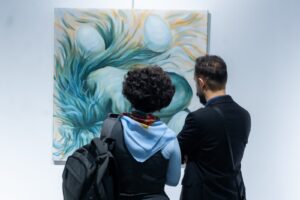
In the end, what I truly hope for in life isn’t to become the most famous artist in the world. What I really want is to become one of the kindest souls anyone could ever meet. More than success, more than recognition- I want my presence to bring light, comfort, and understanding to others. If my art can touch hearts, and if my kindness can leave a trace in someone’s life, then I’ve already achieved everything I ever dreamed of.
Thank you
